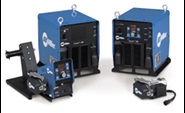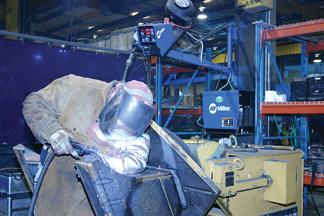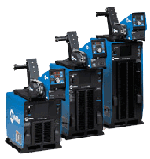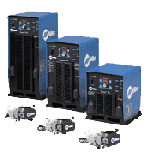Translate Welding Benefits into Bottom-Line Dollars to Justify Equipment Acquisition Costs
Print Article
Learning to speak the "financial language" of those responsible for your company's profits and losses can help you justify the purchase of new welding equipment. Measuring improvement through proven formulas for return on investment (ROI) and payback, as well as documenting potential productivity increases and efficiencies, can go a long way in making new equipment purchases a reality.
Executive Summary
- Welding vendors/suppliers should act as partners interested in your process and growth vs. the typical “sales” approach.
- Don’t buy equipment because it’s new – buy equipment because it will improve your production.
- Using financial metrics such as ROI percentage and payback time.
- Miller’s Advanced Manufacturing Systems (AMS) group will help you translate welding benefits into bottom line dollars.
Negotiating The Jungle Of Equipment Acquisition
When all business projects compete for the same available pool of capital dollars, how can welding engineers, welding production supervisors or operations managers make their request for new welding equipment stand out from competing projects? By learning to speak the “financial language” of people responsible for profit and losses of the business, including general managers, financial officers, controllers, senior management or even bank loan personnel. However, before moving to the capital approval process, welding-oriented personnel need to establish a baseline to measure improvement.
|
Financial Decision Drivers
Key terms and concepts that drive financial decisions:
• ROI = Savings/Investment
– Expressed as a percentage
– Look for ROI greater than 20%
• Payback = Investment/Savings
– Expressed in time
– Look for less than 24 - 36 months
• Payback = Investment/Savings
– Expressed in time
– Look for less than 24 - 36 months
• Other Issues/Measurements
– Lower warranty costs
– Reduced rework
– Higher customer satisfaction rates
– Faster order fill rates
– Safety measures
– Increased efficiencies
– Reduce labor costs
– Chronic personnel shortage (can't find welders)
– Lean manufacturing, kaizen, 5S
• Spending Policy
– What is the dollar limit before a
project must be capitalized?
– Capitalized = cost depreciated over time
– Cost expensed in smaller increments
– Different depreciation methods make a
difference
• Expensed = take the hit now
– No asset on record with residual value
– Immediate impact on bottom line
– Typically easier to justify
Calculating ROI and payback can take several incremental steps and then documenting the improvements offered by new welding equipment and processes.
Representatives from Miller’s Advanced Manufacturing Systems (AMS) group are trained to help you translate welding benefits into bottom line dollars. For instance, is it smarter to expense a single $8,000 system every other month for a year or put in for a $48,000 capital request?
|

Axcess™ and Auto-Axcess™ Series
Solve problems in high volume applications and lower costs associated with rework (gaps, burn-through), pre- and post-weld clean-up (spatter), slow welding speeds and changing processes
|
|
Modern manufacturing and high volume fabrication operations must focus on continuous improvement to remain profitable and competitive. Continuous improvement in manufacturing companies can take many forms. In recent years, manufacturers have applied initiatives such as “5S,” “lean manufacturing,” “six sigma” and “kaizen events.” Subsequent welding improvements obtained through use of digital control technologies in modern welding systems have helped increase throughput, reduce the cost of warranty, reduce scrap, lower cycle times and improve quality. Digital control technology can also lower costs associated with inspection, weld testing, engineering evaluation, disposition and subsequent rework. These technologies can even help overcome the shortage of qualified welding personnel.
To determine the impact of these activities, they first need to be measured to establish a baseline for any potential performance improvement. Note that the real impact of improving a welding process may be felt beyond the welding cell in upstream or downstream operations. Upstream areas include the tooling, forming, stamping, bending, fixturing, and even the associated piece part tolerances and weld prep (grinding or shot blasting to remove mill scale, degreasing, applying anti-spatter solution, etc.). Downstream areas include rework and repair stations, inspection and paint prep (removing weld spatter, grinding, polishing).
Because welding can affect a broad scope of the whole manufacturing process, measuring the impact of new welding processes or equipment may require the input of other areas affected by welding. Often, companies form purchasing or project teams that will include a technical person who specifies the welding equipment (typically the welding supervisor/ engineer/ manager), a financial approval person (usually from management), a representative from the purchasing department, a safety manager, a maintenance person and someone representing the welding operators.
Note that labor may account for a significant portion of your total manufacturing costs, but it is equally important to understand material costs, utilization costs and cost avoidance opportunities, especially if production rates are increasing. Each situation will differ. To help you understand your costs—and to gain a valuable outside perspective—work with equipment suppliers, integrators and distributors who take a consultative approach.
A good vendor/supplier partner wants to explore and understand your operation by asking a lot of open-ended questions that will allow you to explain your issues in depth. Be wary of the stereotypical “sales” guy who does all the talking and offers a quick solution. Rather, they should ask questions to help discover your needs and uncover cost-saving opportunities. Good questions are along the lines of “What are your welding problems and their implications?” or “If we changed factor X, how would it affect your organization?” A good consulting partner probes for your needs in depth and listens most of the time. He/she should want to get out of the conference room or office and walk the production floor with you. Only through a deep understanding of your manufacturing processes can an outside consultant determine if he/she can offer solutions that will solve your problems, benefit your organization and be economically justifiable.
 |
Switching to AccuPulse enabled this fabricator to standardize on one wire, one process and one shielding gas for most of its welding. That saved up to $2,000 per day as a result of, among other things, eliminating the need to grind the spatter associated with short circuit MIG and the chipping of slag associated with flux cored welding.
|
A supplier partner must truly seek a solution to your problem rather than the sale of a welding system. In manufacturing, or any other business for that matter, no one should expect you to acquire equipment because it’s new or technically interesting. Isn’t what you need a way to lower your entire operational costs over time? Don't you want a solution to a problem and the economic justification that spending a dollar today will save much more than that over a period of time? This justification is the key for most financial people in your company.
The Time Value of Money
To successfully acquire new equipment, people such as welding engineers and maintenance superintendents also need to understand the time value of money. To start, consider that your company can receive a 10-percent return—and at relatively low risk—by investing in mutual funds and stocks. When it comes to capitalized expenditures, any equipment that doesn't produce a greater return may actually deplete company resources (assuming you can continue to get by with your current welding machines). The same holds true for equipment that doesn't have a payback time of 24 to 36 months or less.
To differentiate your request, translate its benefits into financial metrics (ROI percentage and payback time), under-stand your company's capital expenditure policies and learn what other key measurements management might use.
Calculating ROI & Payback
To increase the approval potential for for your project, refer the the AMS Economic Evaluation Summary table shown below.
The numbers used in this example are based on a real situation. This customer had poor part fit-up which necessitated a multi-pass welding technique to fill the gaps. This technique slowed cycle times, as well as increased spatter and the likelihood of faulty arc starts. To solve the problem, the customer looked at new technology, then implemented a process that welded their part in one pass while also compensating for gaps, reducing spatter, improving bead appearance, cutting arc start errors in half, reducing consumable use and reducing the need to clean the fixture.
The solution reduced cycle time from 144 seconds to 84 seconds, which represented a throughput improvement of 18 parts/hour and lowered labor/part costs by 42 percent. Sounds great, but it's not enough to justify investing $10,250 in a new welding solution because the benefits aren't phrased in financial terms. Fortunately, the Economic Evaluation Summary does just that. Based on an annual labor savings of $66,171, this company will receive a 433% ROI and experience a payback time of 2.77 months—which makes this capital expenditure a slam dunk for the finance officer to approve.
|
AMS Economic Evaluation Summary
|
| 1. |
Estimated Annual Savings (present minus proposed costs (table below)
|
$66,171 |
| 2. |
Investment |
$10,250
|
| 3. |
Annual Depreciation (Line 2 divided by 5 years) (assumes straight line depreciation) |
$ 2,050 |
| 4. |
Annual Savings After Depreciation (Line 1 minus Line 3) |
$64,121
|
| 5. |
Profit After Taxes (66% of Line 4) |
$42,320 |
| 6. |
Annual Cash Savings (Line 5 plus Line 3) |
$44,370 |
| Return on Investment (Line 6 divided by Line 2 X 100) |
433 % |
| Payback Period (Line 2 divided by Line 6 X 12 months) |
2.77 months |
|
Welding Cost Savings Guide
|
|
Annual Costs Present Method
|
Annual Costs Proposed Method
|
|
Labor/Time Costs
|
|
|
- Pre-welding(applying anti-spatter, etc.)
|
$____________ |
$____________ |
|
|
$____________ |
$____________ |
- Post-welding (grinding, rework, etc.)
|
$____________ |
$____________ |
|
|
$____________ |
$____________ |
|
|
$____________ |
$____________ |
|
|
|
|
Consumables Costs
|
|
|
|
|
$____________ |
$____________ |
|
|
$____________ |
$____________ |
- Abrasives, grinding disks, etc.
|
$____________ |
$____________ |
|
|
$____________ |
$____________ |
|
|
$____________ |
$____________ |
|
|
$____________ |
$____________ |
|
|
|
|
Other Costs
|
|
|
| Utility bills |
$____________ |
$____________ |
| Warranty work |
$____________ |
$____________ |
| Overtime pay |
$____________ |
$____________ |
|
|
|
| Total Costs |
$____________ |
$____________ |
When communicating with the financial stakeholders of business, there is no substitute to understanding their terminology, spending policy and driving forces. Simply do the math to calculate ROI and payback on what you know or have measured about welding process improvements. However, reaching the point where you have the cost savings calculated can take several incremental steps, including trials on your own shop floor and subsequently documenting the improvements offered by new welding equipment and processes. Miller's Advanced Manufacturing Systems (AMS) group representatives are welding experts focused on the different needs and types of manufacturing applications. They are trained to help high volume fabricators and manufacturers negotiate this financial jungle and translate welding benefits into bottom line dollars.
Consider saving this article and passing it onto the next sales person who knocks on your door and knows everything about their products and nothing about how to save you money…there are still a lot of them out there!
Axcess—Bottom Line Systems
The following are features of the Axcess System that have been used to reduce overall welding costs as well as other manufacturing and labor costs associated with welding operations. Every application is different, yielding different results; costs also will vary from application to application. The key is to identify the areas of costs most important to your manufacturing operations. These can be found upstream and downstream of your welding operations as well.

Axcess Systems
300, 450 and 675 amp systems
Digital control technology combined with an inverter welding power source. Designed to reduce the complexity of a semi-automatic pulsed MIG system

Auto-Axcess Systems
For robotic automation
Seamless integration of digital control technology combines an inverter welding power source and robotic interface
|
FEATURE
|
ADVANTAGE
|
BENEFIT
|
AccuPulse™
|
Better Arc Control
|
- Increased Travel Speeds
- Increased Deposition Rates
- Reduced Spatter
- Reduced Rework
- Use Larger Diameter Wire
- Better Gap Filling
- No Arc “Cross- Talk” interference
|
Auto-Line™
|
Eliminate Effects of Primary Power Variation
|
- Reduce Variation between Shifts
- Assures Same Performance Location — World Wide
- Eliminate primary power as a source of manufacturing variation
|
SureStart™
|
Arc Starts Perfected
|
- Reduced Downtime
- Better Contact Tip Life
- Reduced Spatter
- Less Rework
- Reduced Scrap
|
Digital Control
|
Flexibility and Control
|
- Easy Updates for Machines
- Set Locks and Limits
- E-Mail Weld Programs
- Backup Weld Programs to Computer
- Remote Program Select Permits on-the-fly Process Changes
- Trigger Program Select Reduces Operator Trips Back to Welder
|
High volume fabricators and manufacturers can find additional resources at MillerWelds.com/AMS.